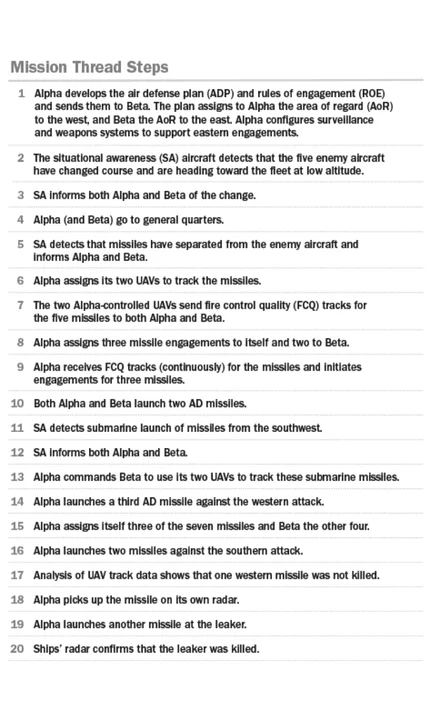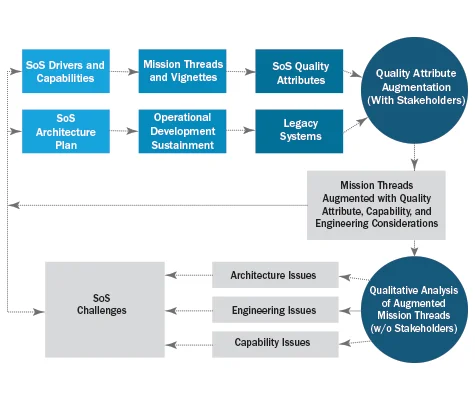An Introduction to the Mission Thread Workshop
PUBLISHED IN
Software ArchitectureIn Department of Defense (DoD) programs, cooperation among software and system components is critical. A system of systems (SoS) is used to accomplish a number of missions where cooperation among individual systems is critical to providing (new) capabilities that the systems could not provide. SoS capabilities are a major driver in the architecture of the SoS and selection of constituent systems for the SoS. There are additional critical drivers, however, that must be accounted for in the architecture that significantly impact the behavior of the SoS capabilities, as well as the development and sustainment of the SoS and its constituent systems' architectures. These additional drivers are the quality attributes, such as performance, availability, scalability, security, usability, testability, safety, training, reusability, interoperability, and maintainability. This blog post, the first in a series, introduces the Mission Thread Workshop (MTW), and describes the role that it plays in assisting SoS programs to elicit and refine end-to-end SoS mission threads augmented with quality attribute considerations.
A mission thread is a sequence of end-to-end activities and events presented as a series of steps that accomplish the execution of one or more capabilities that the SoS supports. Simply listing the steps and describing them, however, does not reveal all the important concerns associated with cooperation among the systems to accomplish the mission and their ensuing behaviors. Articulating and understanding the architectural considerations associated with the mission threads are therefore critical to identifying any architecture mismatches between systems and the SoS. Mission threads must be augmented with quality attribute considerations.
An MTW uses existing SoS end-to-end mission threads and accompanying architecture plans and augments the mission threads with quality attribute, engineering, and capability considerations with inputs from stakeholders. The MTW identifies architecturally significant SoS challenges that are distilled from the architecture, engineering, and capability issues identified in the post-MTW analysis of the quality attribute augmented mission threads. The MTW also identifies candidate legacy systems that have potential architectural mismatches with the SoS and provides the architecture context from which to perform post-MTW architecture evaluations of the candidate legacy system and software architectures.
A mission thread takes place in the context defined by a vignette. The purpose of a vignette is to describe those environmental factors that may be architecturally significant--that is, they impose a constraint on the architecture that would not exist in the absence of these environmental factors. This story can usually be told in a paragraph or two, with an accompanying context diagram showing the nodes containing the systems.
The quality attribute augmented mission threads and SoS challenges serve as important inputs to architecture development, architecture evaluation, and constituent system and software architecture evaluations. The MTW is based on the principles of the Software Engineering Institute's software architecture methods and practices, extended and scaled into the SoS domain. These principles include
- eliciting stakeholder inputs early in the life cycle
- articulating and addressing the quality attributes that drive the architecture early in the life cycle
- identifying challenges impacting architectural decisions early in the life cycle
Un-augmented mission threads and vignettes are critical inputs to the MTW and are developed during the preparation phase. A vignette is a short story about the environment that provides the context in which the SoS exists. Mission threads and vignettes are developed by the SoS program's architect(s) with assistance from the MTW team and are typically based on existing mission threads/vignettes for the SoS and updated for use in the MTW. Sometimes mission threads or vignettes must be developed from scratch if no relevant ones exist.
Mission Threads and Operational Vignettes
Through our work on a number of SoS and commercial enterprise architectures within the DoD, we have identified three basic types of mission threads:
- An operational mission thread describes how SoS nodes (and perhaps the systems within the nodes) react to an operational stimulus. The operational mission thread is presented as an end-to-end sequence of steps (external events, operator activities, and automated activities) that take place over a time period. For example, an operational mission thread for a DoD command-and-control system might begin with threat detection followed by a number of steps to determine the intent of the threat, make decisions to counter the threat, apply the counter measures, and finally document the commander's assessment of damage after completion.
- A development mission thread focuses on development activities including adding new capabilities, technology refreshment, integration, test, certification, and release.
- A sustainment mission thread focuses on deployment, installation, sustainment, or maintenance. A sustainment mission thread describes how the SoS nodes operate together to sustain the SoS.
Examples
The following examples present an operational vignette for ballistic missile defense in a naval context:
Two ships (Alpha and Beta) are assigned to air defense to protect a fleet containing two high-value assets. A surveillance aircraft and four unmanned aerial vehicles (UAVs; two pairs) are assigned to the fleet and controlled by the ships. A pair of UAVs flying as a constellation can provide fire-control quality tracks directly to the two ships.
A two-pronged attack on the fleet occurs:
- five aircraft-launched missiles from the southeast
- three minutes later, seven submarine-launched missiles from the southwest
The fleet is protected with no battle damage.
An example mission thread (un-augmented) supporting the Ballistic Missile Defense vignette is provided in the following table; it serves as an input to the MTW, and will be augmented with quality attribute, engineering, and capability considerations during the MTW.

Conceptual Flow
The figure below depicts the conceptual flow of the MTW. SoS drivers and capabilities inform the development of vignettes and mission threads from which a set of quality attributes are derived. Plans for SoS architecture development include an initial set of architecture views that support the vignettes and mission threads. Constituent legacy systems are identified for consideration in the SoS architecture, based on the capabilities and mission threads.
The MTW team uses these inputs to augment the mission threads with quality attribute considerations, as well as engineering and capability considerations, with participation from SoS and legacy system stakeholders. The other outputs from the MTW are the SoS challenges derived from the issues identified in the qualitative analysis. The augmented mission threads and challenges will drive important architectural decisions during architecture development.

Concluding Remarks
Many quality attributes in SoS programs require architectural support at various levels, accompanied by analyses of the various architectural approaches and their trade-offs. Failure to address quality attributes in the architectures can lead to serious consequences, such as operational and developmental failures; addressing these late in the development life cycle increases risks to programs. These risks are exacerbated in SoS architectures comprising legacy system and software architectures.
After performing more than 30 MTWs in the context of SoS programs, SEI researchers have observed several trends:
- First, buy-in from the principals and the stakeholders is critical to the success of the approach, as in all stakeholder-focused methods. To encourage buy-in, the SEI's MTW teams often developed an initial thread in the stakeholders' domains for review.
- Strong third-party facilitation has been critical to the success of the MTW approach. Challenges identified by consensus under independent third-party facilitation tend to benefit from higher group buy-in than do challenges identified by various factions among SoS stakeholders. We also discovered that the architectural challenges identified in MTWs often result in updates to the SoS CONOPS and mission needs statements. Although third-party facilitation is important, motivated programs can adopt the MTW process for their own use. For example, after participating in a few MTWs facilitated by the SEI, a DoD Naval program was able to successfully execute its own MTWs.
- SoS architecture principles and guidelines were often absent when we began an engagement. Documenting the principles and guidelines for the SoS architecture is beneficial to drive and constrain the architecture development process for both SoS and constituent systems, including legacy modifications. We found that the MTW approach feeds the development of these principles and guidelines. With proper scoping and selection of vignettes and mission threads, programs easily can attain a high percentage of coverage of their SoS's envisioned capability, which can provide a focused starting point for the architecture development effort.
Overall, our experience in executing a number of MTWs for a variety of clients has been very positive. The clients all gained insight into the desired behavior of their SoS and constituent systems; identified architectural challenges, engineering challenges, and capability gaps; and defined architecture guidelines and principles to guide their development. These outcomes help a program avoid the costly consequences of development and operational failures and lead to more cost-effective and on-time delivery of new capabilities for the SoS.
This blog post is the first in a series on the MTW. Future posts will explore the steps of the MTW in detail and provide examples, experiences, and lessons learned in its application.
Additional Resources
To read the SEI technical report, Introduction to the Mission Thread Workshop, please visit, https://resources.sei.cmu.edu/library/asset-view.cfm?assetID=63148.
To view the presentation, Identifying Architectural Challenges in System of Systems Architectures, please visit
https://www.acq.osd.mil/se/webinars/2014_07_15-SoSECIE-Gagliardi-brief.pdf.
To view the SATURN presentation, Mission Thread Workshop: Lessons Learned, please visit
https://resources.sei.cmu.edu/library/asset-view.cfm?assetid=19898.
To view the SATURN presentation, Mission Thread Workshops: Lessons Learned in End-to-End Capability and Quality Attribute Specification for SoS Architecture Development, please visit https://resources.sei.cmu.edu/library/asset-view.cfm?assetid=19890.
More By The Author
More In Software Architecture
PUBLISHED IN
Software ArchitectureGet updates on our latest work.
Sign up to have the latest post sent to your inbox weekly.
Subscribe Get our RSS feedMore In Software Architecture
Get updates on our latest work.
Each week, our researchers write about the latest in software engineering, cybersecurity and artificial intelligence. Sign up to get the latest post sent to your inbox the day it's published.
Subscribe Get our RSS feed
